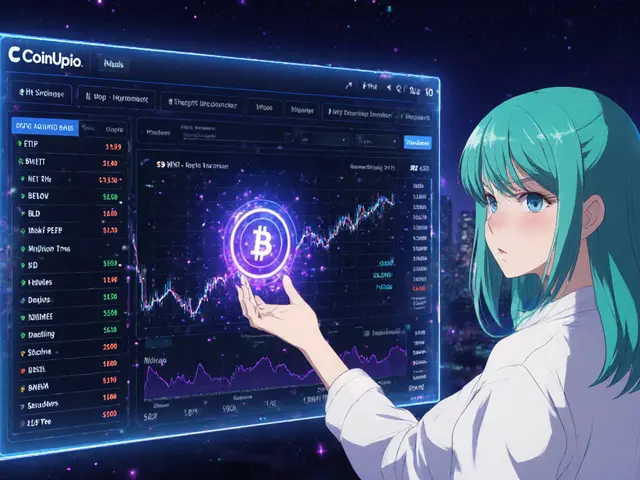Alterdice Trading Fee Calculator
Estimate your trading fees on Alterdice based on your monthly trading volume and asset type.
Quick Takeaways
- Based in Singapore, Alterdice has been operating since 2018 and excludes U.S. users.
- Cold storage holds 98% of funds; two‑factor authentication is optional for all accounts.
- Trading fees max out at 0.2%, with free deposits for all supported assets.
- Daily volume hovers around $50million, offering solid liquidity for most pairs.
- Native apps for iOS, Android, Windows, macOS and Linux keep the platform reachable anywhere.
This Alterdice review looks at the exchange’s security, cost structure, platform reach, and how it stacks up against the big players.
When it comes to crypto trading, Alterdice is a Singapore‑based exchange that launched in October 2018. The service markets itself as “the easiest way to trade, buy and sell digital currencies,” aiming to blend simplicity with a toolbox that’s still beefy enough for seasoned traders.
Where It Operates and Who Can Join
The exchange is headquartered in Singapore a city‑state with forward‑looking crypto regulations. Because of local licensing rules, Alterdice explicitly bars U.S. investors from opening accounts.
Aside from that restriction, the platform welcomes users from most countries, offering a multilingual interface and 24/7 live chat support for help around the clock.
Asset Coverage and Trading Basics
Alterdice lists the usual suspects-Bitcoin the original cryptocurrency, Ethereum the leading smart‑contract platform, and dozens of altcoins like XRP, BNB, Zcash and Litecoin. New listings are announced quarterly, letting the catalog stay fresh without overwhelming newcomers.
Both market and limit orders are supported, and the order‑book depth is generally sufficient for retail‑size trades. The platform also offers price alerts, customizable charting tools, and a “visual order” mode that helps users see exactly where their order will sit in the book.
Security Layers That Keep Funds Safe
Security is the headline act at Alterdice. About 98% of user balances sit in cold storage offline wallets that are never connected to the internet, dramatically lowering the hack surface.
For the remaining hot‑wallet portion, the exchange runs automatic DDoS mitigation, daily backups, and an encrypted data pipeline. Users can enable 2FA two‑factor authentication via authenticator apps or SMS on login, withdrawals, and even API key creation.
No major security breach has been reported since launch, and the platform’s incident‑response plan is published in its help center for added transparency.
Fees, Deposits, and Withdrawals
Alterdice’s fee schedule is tiered by 30‑day trading volume. The biggest traders enjoy a 0.05% maker fee, while the default rate for most users sits at 0.2% per trade. There are no hidden spreads; the exchange shows the exact fee before you confirm.
Deposits are free across all supported assets, which is a nice perk compared with some rivals that charge network fees on top of the blockchain’s own cost. Withdrawal fees are modest-typically a few cents for Bitcoin or a flat $1‑$2 for most altcoins-and they’re clearly listed on the withdrawal page.
Platforms: Web, Desktop, and Mobile
The service runs as a SaaS web portal and also offers native applications for iPhone, iPad, Android phones, Windows, macOS, and Linux. The mobile app provides real‑time price alerts and one‑click order placement mirrors the desktop experience, making it easy to hop on a trade while commuting.
All apps support fingerprint or Face ID login, and the desktop client integrates with hardware wallets like Ledger and Trezor for an extra security layer.

API Access and Ecosystem Integrations
Developers and algorithmic traders can tap into a RESTful API that exposes market data, order execution, and account management endpoints. The documentation includes code snippets in Python, JavaScript, and Go, making it straightforward to build bots or connect portfolio trackers.
Through built‑in integrations, Alterdice syncs with platforms such as CoinGecko for price feeds, Koinly for tax reporting, and CryptoCompare for market analysis. These connections let users pull their trade history into external dashboards without manual CSV juggling.
Liquidity and Real‑World Trading Volume
On June302019 the exchange recorded a 24‑hour volume of roughly $40million. By December22021 that number rose to $51million, and recent data from mid‑2025 still hovers in the $45‑$55million range daily. That steady volume translates into decent order‑book depth for most popular pairs, though ultra‑high‑frequency traders might still prefer mega‑exchanges with multi‑billion daily flow.
In practice, a typical retail trader won’t hit slippage on a $5,000 Bitcoin order, but a $500,000 block could see a few basis points of price movement.
Customer Support and Education
Alterdice offers live chat during business hours and a 24/7 ticket system for urgent issues. The help center includes step‑by‑step guides, video webinars, and even in‑person workshops in major Asian cities.
For beginners, the “Getting Started” series walks through account creation, deposit procedures, and basic order types. Advanced users can dive into the “Pro Trading” tutorials that cover API key management, margin‑like features (although true margin trading isn’t offered), and risk‑management best practices.
Pros and Cons at a Glance
- Pros:
- Strong cold‑storage ratio and optional 2FA
- Clear, capped fee structure (max0.2%)
- Free deposits on every asset
- Native apps for all major OSes
- Comprehensive API with good documentation
- Cons:
- No U.S. access limits market reach
- Liquidity below top‑tier exchanges for thin altcoins
- Derivatives, futures, and margin products are absent
How Alterdice Stacks Up Against the Big Guys
| Feature | Alterdice | Binance | Coinbase |
|---|---|---|---|
| Base of operations | Singapore | Malta / Global | USA |
| Supported assets (approx.) | 200+ | 600+ | 150+ |
| Max trading fee | 0.20% | 0.10% (maker) | 0.50% (flat) |
| Cold‑storage ratio | 98% | ~95% | ~94% |
| US access | No | Limited | Yes |
| Mobile apps | iOS, Android, desktop | iOS, Android, desktop | iOS, Android, desktop |
| API availability | Full REST | Full REST + WebSocket | REST (limited) |
Final Verdict
If you value a clean interface, solid security, and straightforward fees, Alterdice is a compelling middle‑ground choice. It won’t beat Binance on sheer liquidity or Coinbase on regulatory comfort for U.S. residents, but it does offer a user‑friendly experience that’s hard to find on the larger platforms.
For traders who are comfortable with modest volume and don’t need exotic products like futures, the exchange delivers a reliable, secure environment. Those chasing the deepest order books or needing U.S. compliance might look elsewhere, but anyone else will find a well‑rounded service that respects both ease of use and safety.
Frequently Asked Questions
Is Alterdice safe for storing large amounts of crypto?
Yes. With 98% of funds kept in cold storage, mandatory 2FA, and daily backups, the platform follows industry‑standard security practices. While no system is 100% risk‑free, Alterdice’s track record shows no major breaches since its 2018 launch.
Can I trade on Alterdice from the United States?
No. The exchange explicitly blocks U.S. IP addresses and requires users to confirm they are not residents of the United States during registration.
What are the deposit and withdrawal fees?
Deposits are free for all supported cryptocurrencies. Withdrawal fees vary by coin but are generally low - for example, Bitcoin withdrawals cost about $0.0005 BTC, and most altcoins have a flat $1‑$2 fee.
Does Alterdice offer a mobile app?
Yes. Native iOS and Android apps provide real‑time price alerts, one‑tap order execution, and fingerprint or FaceID login.
Is there an API for automated trading?
A full REST API is available, with endpoints for market data, order placement, and account information. Documentation includes sample code in several programming languages.







Comments
MD Razu
October 1, 2025 AT 02:13 AMWhen we contemplate the architecture of security, we must first acknowledge that every protocol is a promise, a covenant between the custodians of digital wealth and the unseen forces that seek its disruption. Alterdice, by virtue of its Singaporean domicile, operates under a regulatory framework that aspires toward clarity, yet the shadows of jurisdictional ambiguity persist. The cold‑storage ratio of ninety‑eight percent is commendable, but it is not an inviolable shield; the remaining two percent in hot wallets remains a vector for exploitation. Two‑factor authentication, while optional, becomes a philosophical question of trust versus convenience, echoing the age‑old debate of liberty constrained by vigilance. Moreover, the exchange’s lack of historical breaches does not guarantee immunity; it merely reflects a window of operational fortuity. The tiered fee structure, capping at zero‑point‑two percent, reveals a commitment to transparency, but the absence of margin products may signal a deliberate restraint against leverage‑induced volatility. Liquidity, hovering in the mid‑fifties million dollars daily, provides sufficient depth for retail participants, though the occasional thin altcoin orderbook can betray the limitations of a mid‑sized market. Integration with hardware wallets like Ledger and Trezor further anchors the narrative of security, yet it also introduces a reliance on external devices that can be lost or compromised. The API, while robust, opens a portal for automated strategies that could, in aggregate, stress the system if not governed by prudent throttling. User experience across web and native apps suggests a seamless interface, yet the underlying complexity remains a labyrinth for the uninitiated. In the grand mosaic of exchanges, Alterdice positions itself as a bridge between the simplicity of a user‑friendly platform and the rigor of institutional safeguards. This duality reflects a broader tension in the crypto ecosystem: how to democratize access without diluting protection. As we assess the exchange, we must weigh these contradictions, recognizing that security is not a static state but an evolving discourse. Ultimately, the choice to entrust funds to Alterdice hinges on the individual's appetite for risk, their appreciation of transparency, and their willingness to navigate the nuanced interplay of convenience and defense. The future, ever uncertain, will test these foundations, and only time will reveal whether the promises made today endure tomorrow.
Charles Banks Jr.
October 6, 2025 AT 21:23 PMWow, a crypto exchange that actually *offers* free deposits-what a novelty. Guess the real surprise is that they still manage to charge you for withdrawals.
Ben Dwyer
October 12, 2025 AT 16:33 PMFor newcomers, the free‑deposit policy is a solid hook; you can start experimenting without worrying about network fees. The UI is clean, and the charting tools give you enough data to make informed decisions. If you’re comfortable with basic market and limit orders, you’ll find the platform intuitive. Remember to enable two‑factor authentication for an extra security layer.
Lindsay Miller
October 18, 2025 AT 11:43 AMI appreciate how the exchange explains the fee schedule up front; no hidden surprises. The cold‑storage ratio gives peace of mind for larger holdings. Also, the live chat support feels genuinely helpful when I needed guidance.
Katrinka Scribner
October 24, 2025 AT 06:53 AMNice app, love the emojis! 😊
VICKIE MALBRUE
October 30, 2025 AT 02:03 AMGreat platform for beginners
Waynne Kilian
November 4, 2025 AT 21:13 PMThe inclusive approach of supporting many languages really opens doors for a global audience. Still, the lack of US access does limit potential growth in a major market. I think the balance between security and ease of use is well struck. Perhaps more educational webinars could further boost confidence among new traders.
Naomi Snelling
November 10, 2025 AT 16:23 PMThey say they keep 98% of funds cold, but have you considered who actually controls those wallets? The fact that they block US IPs might be a smokescreen for deeper regulatory issues. Also, the optional 2FA feels like a suggestion rather than a requirement-odd for a platform that touts security. There’s a whole hidden agenda when you look past the marketing fluff.
Michael Wilkinson
November 16, 2025 AT 11:33 AMDon't be fooled by the marketing hype; the optional 2FA is a joke. If you want real security, you need to demand mandatory two‑factor every time you log in, withdraw, or use the API. Anything less is a lax approach that could cost you dearly.